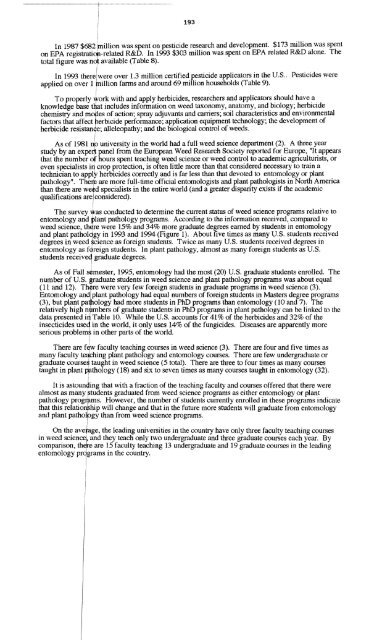Vol. 51â1997 - NorthEastern Weed Science Society
Vol. 51â1997 - NorthEastern Weed Science Society
Vol. 51â1997 - NorthEastern Weed Science Society
You also want an ePaper? Increase the reach of your titles
YUMPU automatically turns print PDFs into web optimized ePapers that Google loves.
I<br />
I<br />
I<br />
193<br />
In 1987 $682Imillion was spent on pesticide research and development. $173 million was spent<br />
on EPA registratioa-related R&D. In 1993 $303 million was spent on EPA related R&D alone. The<br />
total figure was nqt available (Table 8).<br />
I<br />
In 1993 therelwere over 1.3 million certified pesticide applicators in the u.s.. Pesticides were<br />
applied on over 1 million farms and around 69 million households (Table 9).<br />
I<br />
To properly ~ork with and apply herbicides, researchers and applicators should have a<br />
knowledge base that includes information on weed taxonomy, anatomy, and biology; herbicide<br />
chemistry and mies of action; spray adjuvants and carriers; soil characteristics and environmental<br />
factors that affect erbicide performance; application equipment technology; the development of<br />
herbicide resistanq ; alleleopathy; and the biological control of weeds.<br />
As of 1981 n~ university in the world had a full weed science department (2). A three year<br />
study by an expert panel from the European <strong>Weed</strong> Research <strong>Society</strong> reported for Europe, "Itappears<br />
that the number orhours spent teaching weed science or weed control to academic agriculturists, or<br />
even specialists itj crop protection, is often little more than that considered necessary to train a<br />
technician to apply herbicides correctly and is far less than that devoted to entomology or plant<br />
pathology". There are more full-time official entomologists and plant pathologists in North America<br />
than there are weedspecialists in the entire world (and a greater disparity exists if the academic<br />
qualifications are)considered).<br />
I<br />
The survey Xias conducted to determine the current status of weed science programs relative to<br />
entomology and lant pathology programs. According to the information received, compared to<br />
weed science, th re were 15% and 34% more graduate degrees earned by students in entomology<br />
and plant pathology in 1993 and 1994 (Figure 1). About five times as many U.S. students received<br />
degrees in weed science as foreign students. Twice as many U.S. students received degrees in<br />
entomology as foreign students. In plant pathology, almost as many foreign students as U.S.<br />
students receiv~ graduate degrees.<br />
As of Fall scPmester, 1995, entomology had the most (20) U.S. graduate students enrolled. The<br />
number of U.S. graduate students in weed science and plant pathology programs was about equal<br />
(11 and 12). Tbere were very few foreign students in graduate programs in weed science (3).<br />
Entomology andlplant pathology had equal numbers of foreign students in Masters degree programs<br />
(3), but plant pathology had more students in PhD programs than entomology (10 and 7). The<br />
relatively high niunbers of graduate students in PhD programs in plant pathology can be linked to the<br />
data presented itl Table 10. While the U.S. accounts for 41 % of the herbicides and 32% of the<br />
insecticides used in the world, it only uses 14% of the fungicides. Diseases are apparently more<br />
serious problems in other parts of the world.<br />
I<br />
There are f~w faculty teaching courses in weed science (3). There are four and five times as<br />
many faculty teaching plant pathology and entomology courses. There are few undergraduate or<br />
graduate courses taught in weed science (5 total). There are three to four times as many courses<br />
taught in plant Prathology (18) and six to seven times as many courses taught in entomology (32).<br />
,<br />
It is astounding that with a fraction of the teaching faculty and courses offered that there were<br />
almost as many ~tudents graduated from weed science programs as either entomology or plant<br />
pathology programs, However, the number of students currently enrolled in these programs indicate<br />
that this relationship will change and that in the future more students will graduate from entomology<br />
and plant pathology than from weed science programs.<br />
r<br />
On the ave~age, the leading universities in the country have only three faculty teaching courses<br />
in weed. Scienc~· and they teach only t~o undergraduate and three graduate courses each year. By<br />
companson, th e are 15 faculty teaching 13 undergraduate and 19 graduate courses in the leading<br />
entomology pr grams in the country.<br />
I<br />
I<br />
i<br />
I
















